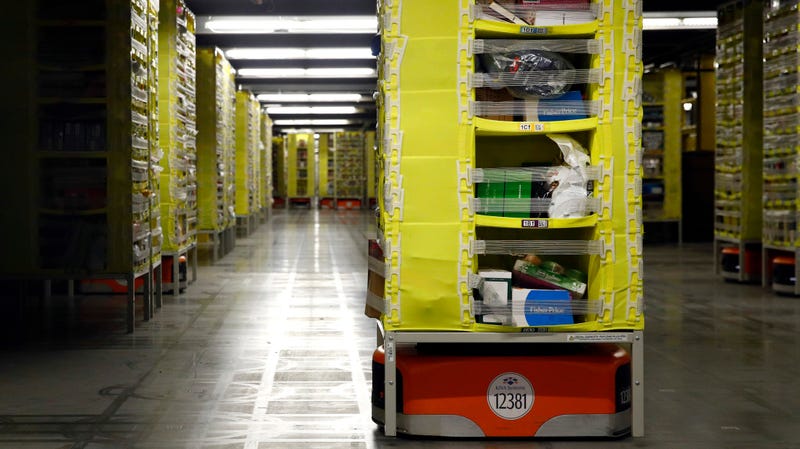Amazon's Experiment in Getting Rid of Cashiers Said to Expand to Larger Test Stores
By Tom McKay
Robots at an Amazon warehouse in Baltimore.
Photo: Patrick Semansky (AP)
E-commerce titan Amazon—not exactly known as a place that appreciates having to deal with human employees, and that in fact would seem to rather replace many of them with nightmarish robotic jellyfish—is reportedly expanding its tests of cashier-less stores to include larger retail environments, the Wall Street Journal reported on Sunday.
According to the Journal, Amazon has made progress with its experimental system to track what shoppers pick up and charge them automatically as they leave the store in smaller environments. But sources said it’s struggling to make the concept work on the scale of something more like a Whole Foods (an Amazon subsidiary):
The online retail giant is experimenting with the technology in Seattle in a larger space formatted like a big store, the people said. The systems track what shoppers pick from shelves and charges them automatically when they leave a store. Although the technology functions well in its current small-store format, it is harder to use it in bigger spaces with higher ceilings and more products, one of the people said, meaning it could take time to roll out the systems at more larger stores.
It is unclear whether Amazon intends to use the technology for Whole Foods, although that is the most likely application if executives can make it work, according to the people. Amazon has previously said it has no plans to add the technology to Whole Foods.
Amazon has already opened smaller Amazon Go stores that rely on the technology, where shoppers scan an app-generated code on their phones and then walk out with their merchandise without encountering a human cashier. The company clearly has its eyes on the brick-and-mortar market with its 2017 acquisition of Whole Foods and its expansion into physical locations elsewhere, and it’s been reported to be eyeing opening as many as 3,000 Amazon Go locations to compete with places like 7/11 and CVS.
It’s easy to see why Amazon is so interested in automation: It already treats its masses of low-wage human workers like machines to maximize efficiency and profit, so it’s a tiny leap to just treating machines like machines. This is not exactly a great sign for human staff, who will be ripe for replacement at all points of its supply chain when Amazon figures out how to fully automate those tasks that still require human involvement.
Some research has suggested that job losses from automation could be compensated for by other factors, though that transition may not be so tidy for millions of people. It’s also possible that companies could simply shift employees to other roles, though that may amount to little more than a PR-friendly talking point. There’s also the argument that growth in e-commerce is creating more jobs in retail infrastructure and distribution than it will eliminate, though a broad spectrum of experts Gizmodo asked earlier this year generally seemed pretty concerned about how such an economy will treat labor.
In the meantime, Amazon seems to still have some glitches to work out before it can say goodbye to pesky human labor. In 2017, the Amazon Go system was reportedly still having problems with things like differentiating individual shoppers who looked vaguely similar or moved too fast, as well as things like merchandise being moved. According to the Journal, another issue that would bedevil any attempts to automate a chain like Whole Foods is that not all items are neatly packaged with conveniently machine-trackable labels, such as produce sold by weight.
No comments:
Post a Comment